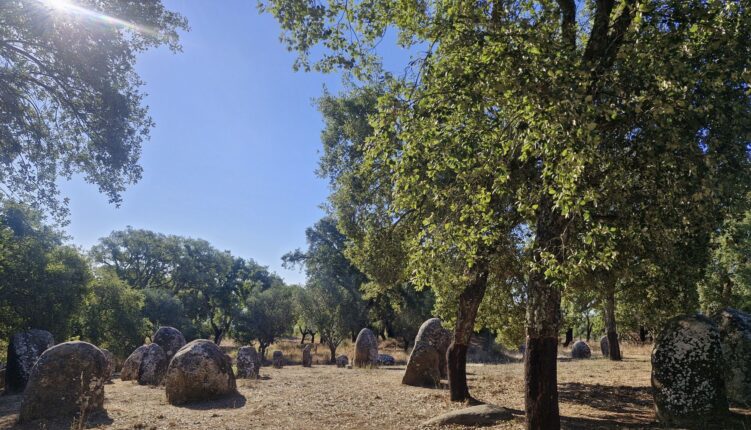The Almendres Cromlech, known in Portuguese as Cromeleque dos Almendres, is one of Europe’s most remarkable megalithic monuments.
Located near the village of Nossa Senhora de Guadalupe, close to Évora, this ancient site stands as a silent witness to human activity dating back over 7,000 years.
With its origins in the 6th millennium BC, the Almendres Cromlech predates even Stonehenge, offering an extraordinary glimpse into Portugal’s prehistoric past.
A “cromlech” refers to a megalithic structure composed of large standing stones, often arranged in circular formations.
The Almendres complex features 95 granite monoliths set out in small groups across the landscape.
The oldest stones, from the Early Neolithic period, form two or three concentric circles of smaller monoliths on the western side. Later, during the Middle Neolithic, larger menhirs were added in two irregular but concentric ellipses. In the site’s final phase, during the Late Neolithic, modifications suggest the space evolved into a setting for social or religious ceremonies.
Many of the stones appear to have been deliberately aligned with celestial events. An isolated single menhir, approximately 4.5 metres tall and 0.9 metres in diameter, is around 1.4kms northeast of the cromlech. A line drawn from the Almendres Cromlech to this menhir points roughly towards the sunrise at the Winter Solstice.
About a dozen of the monoliths also feature carved drawings, offering a glimpse into the symbolic or ritual expressions of the prehistoric people who created them.
Vale de Maria do Meio Comlech
Just a few kilometres from Almendres, another cromlech can be found; the Cromeleque de Vale Maria do Meio. Also dating from the Neolithic period, this smaller circle of standing stones lies is less extensive and shares similar structural and astronomical characteristics, suggesting that both sites were part of a broader network of ceremonial or observatory locations within the Alentejo landscape.
Further east, close to the Spanish border, stands the Xerez Cromlech (Cromeleque do Xerez), near the town of Monsaraz.
Believed to date from the 5th or 4th millennium BCE, this megalithic complex once stood in a different location but was moved due to the creation of the Alqueva Dam. The monument was carefully dismantled in November 2001 and reassembled near the Orada Convent in June 2004. It was the only prehistoric monument to be relocated, as the dam’s waters submerged several other archaeological treasures, including prehistoric rock engravings and the Roman-era Castle of Lousa.
In the district of Évora alone, there are 10 known megalithic sites, over 100 isolated menhirs, and 450 megalithic settlements – making this region one of the richest prehistoric landscapes in Europe.
Today, cromlechs remain a mysterious link between us today and the earliest communities of the Iberian Peninsula.
If you are interested in Portugal’s history, find out more about significant landmarks, institutions and culinary delights and even some myths and legends.

